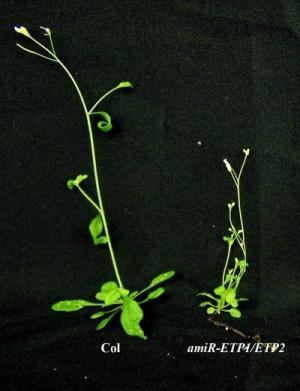Famous for its effect on ripening fruits and flowers, ethylene plant hormones shorten the shelf life of fruits and plants by putting them in a 'fast rewinding' state. In recent years, scientists have studied a lot about the different components that transmit ethylene signals inside cells. The proteins that control the central ethylene reaction, called EIN2, resisted all their efforts.
Finally after more than a decade of exploration, a group of researchers led by Dr. Professor Jospeh Ecker of the Plant Biology Laboratory and Director of the Genetic Analysis Laboratory of Salk Academy , succeeded in binding this protein. They found that ethylene's balance balanced the EIN2 protein, allowing it to focus enough to transmit ethylene signals.
Their findings, published February 15, 2009 in Genes and Development, are an important step in recognizing EIN2's role in the development and transformation of essential processes to improve agriculture, reduce losses due to ethylene-related problems.
"Ethylene is involved in many processes and we know from gene experiments that EIN2 is at the heart of the ethylene signaling path, but for a very long time we could not understand how it was controlled," Ecker said. how. Now that we know that EIN2 is caused by dominant protein degradation, we can begin to understand how it stimulates different ethylene reactions in plants. '
 Plants with reduced levels of ETP1 and ETP2 (on the right) are smaller than regular plants (on the left), and give off unusual flowers with pistils emerging from unopened flower buds. (Photo: Dr. Hong Qiao, Salk Biological Research Institute). All aspects of plant life are influenced by ethylene: It results in plant germination and triple response in seedlings. It controls root growth and small patches of legume nitrogen legumes. It stimulates the ripening of the fruit, the destruction of flowers and the process of ablation, allowing plants to drop fruits, leaves and flowers. However, it also protects the plant from pathogens and environmental stresses.
Plants with reduced levels of ETP1 and ETP2 (on the right) are smaller than regular plants (on the left), and give off unusual flowers with pistils emerging from unopened flower buds. (Photo: Dr. Hong Qiao, Salk Biological Research Institute). All aspects of plant life are influenced by ethylene: It results in plant germination and triple response in seedlings. It controls root growth and small patches of legume nitrogen legumes. It stimulates the ripening of the fruit, the destruction of flowers and the process of ablation, allowing plants to drop fruits, leaves and flowers. However, it also protects the plant from pathogens and environmental stresses.
While the power of ethylene has been exploited by ancient Egyptians, it has also caused significant damage to flower growers, suppliers and growers. Only a rotten apple that produces ethylene will accelerate the ripening of nearby apples and cause them to break down as well. The impact of transport and handling also increases ethylene production in flowers.
Dr. Hong Qiao, a member of Ecker's lab, said: 'Ethylene plays an important role in our daily lives and the ethylene overproduction causes huge economic losses every year. Once we have gained knowledge of ethylene signaling pathways, we can use that knowledge to improve plant resistance to pathogens or drought. '
When there is no ethylene, a protein called CTR1 will close the ethylene signaling pathway by inhibiting the EIN2 protein. When ethylene binds to receptors, CTR1 will loosen control over EIN2 and EIN2 will start again. But no one knows the mechanism of this process.
Because the gene's activity, which was isolated in Ecker's laboratory in 1995, did not change, Qiao took a closer look at protein levels. EIN2 is a short-lived protein, but when the ethylene concentration in the plant is increased, EIN2 does not degenerate but begins to accumulate.
Additional experiments showed that two F-box proteins, ETP1 and ETP2 (EIN2 target proteins 1 and 2), signaled the degradation of EIN2 when it was not needed for signaling. When ethylene is present, both protein F-boxes stop working and EIN2 works normally.
Ecker explains: 'Protein degradation is an important topic in plant biology and is associated with some signaling pathways. This type of control is like putting your foot on both the accelerator and the brake pedal at the same time, then releasing the brake pedal. It allows cells to react faster to incoming information. '
When Qiao disabled both ETP1 and ETP2 the ethylene signaling pathway was always active. When she raised their levels above normal, plants did not react to the presence of ethylene. Qiao said: 'We have confirmed the central role of EIN2. Now we can continue this path and fill the gap between EIN2 and other components of the signal line '.
Fellows Katherine N. Chang, and postdoctoral researcher Dr. Junshi Yazaki of Ecker's lab also contributed to the study.
The research is funded by the National Science Foundation.
Why fruits ripen and flowers die
More Science Stories
- Notes to keep fruits and vegetables the most nutritious
- Climate tree - Thanh Cuong (Quercus glauca)
- How to grow and care vy wing flowers
- Exotic 'breeding' like figs, bananas produce green flowers in Da Lat
- The fruits absolutely do not eat if lost in the forest
- The secret to keeping fresh flowers long during Tet holidays
- 6 types of morning fruits are 'medicinal herbs' dinner is 'poison'
- Meaning of five fruits in 3 regions culture
- Revealing Chinese fruit
- Discover the festival of death flowers in Japan
- Silly at the beauty of
- Methods of preserving some flowers after harvest
 Why do potatoes have eyes?
Why do potatoes have eyes? 'Tragedy' the world's largest carnivorous life: Death becomes ... public toilet
'Tragedy' the world's largest carnivorous life: Death becomes ... public toilet Tomatoes were once considered 'poisonous' for 200 years
Tomatoes were once considered 'poisonous' for 200 years Detecting microscopic parasites on human face
Detecting microscopic parasites on human face